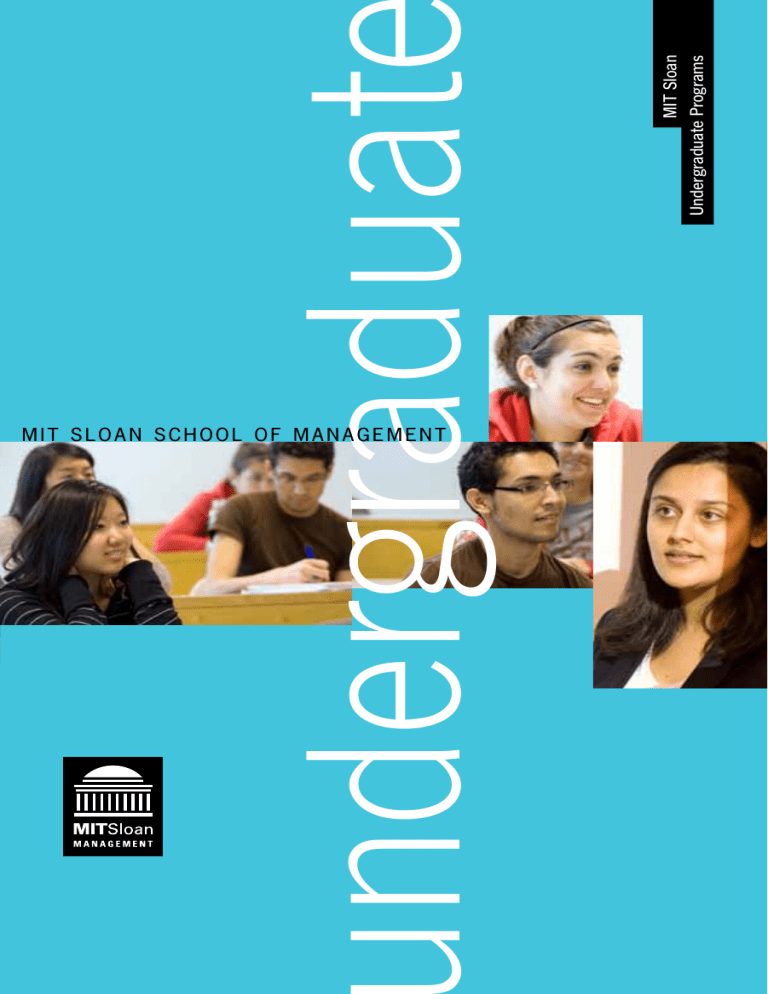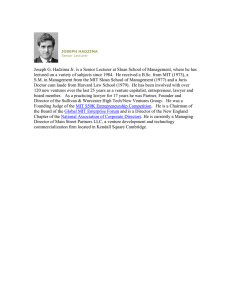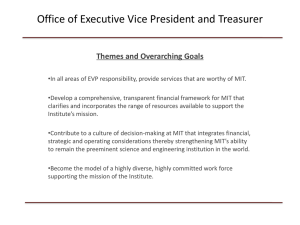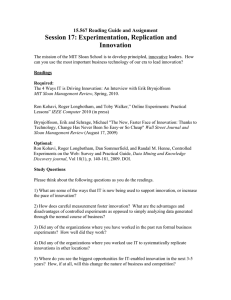
MIT Sloan
Undergraduate Programs
ndergraduat
mit sloan school of management
“One of the best things about being in Course 15 is that you continuously interact with so many of
the up-and-coming business leaders in the world today; through your interactions, you can see that
these brilliant individuals are not very different from you, and with some help you can accomplish
some great feats of your own.” –cathy melnikow ’10
Overview of Programs
The MIT Sloan School of Management (Course 15)
offers unsurpassed management education to top students
from around the world. The undergraduate program was
founded in 1914 as a curriculum in Business and Engineering Administration. Since then, MIT management faculty
and alumni have led the way in advancing the theory and
practice of management. Today, MIT Sloan offers three
distinctive undergraduate programs:
• Bachelor of Science (SB) in Management Science
• Minor in Management
• Minor in Management Science
2
SB in Management Science
what is management science?
Management science (also known as operations research),
is a professional discipline that employs scientific and
mathematical approaches to managerial decision-making.
It combines quantitative methods such as probabilistic
analysis, statistical inference, optimization, mathematical
modeling, and computer programming with qualitative
skills in communication, psychology, and organizational
behavior. Management science is applied in virtually all
areas of business, industry, and government, including:
• Financial services
• Marketing
• Operations management
• Technology, engineering, and manufacturing
• Transportation systems
• Service industries such as health care and insurance
• Strategic counsulting
4
Management science is concerned with the design
and administration of complex systems, and it is used to
investigate a wide range of strategic and logistical problems.
For example, a financial analyst might apply management
science techniques to answer the following questions:
• W
hat portfolio of investments has the highest return for a
given level of risk?
• What is the relation between option prices and stock prices?
• W
hat is the optimal combination of financial products for a
given client?
These are complex, multifaceted problems involving
uncertainty and risk. Management science provides a
systematic approach to problem solving, using quantitative tools to support decision making. These techniques are
combined with qualitative methods that address a range
of interrelated business objectives. Management science
is not a purely theoretical discipline; it takes real world
complications and constraints into consideration in an effort
to provide sound, viable solutions to managerial problems.
This can result in a significant savings of time, money,
resources, and even lives.
“The classes are great, especially 15.279.
It taught me so much about communication
and about myself, all in a supportive environment that really fostered my learning. I think
it is one of the most applicable classes I have
taken at MIT, and it’s something I wish every
student had the opportunity to experience.”
—melissa crowell ’11
6
management science at mit
MIT Sloan’s program in management science is consistently
ranked as one of the best undergraduate business programs
in the nation by U.S. News and World Report, and it continues to be one of the most popular majors at the Institute.
The MIT Sloan School of Management is in a unique
position to offer an outstanding program in management
science. All MIT undergraduates, regardless of major,
complete a common set of Institute requirements. These
required courses (in math, physical science, humanities,
arts, and social science) provide a strong foundation for the
study of management science. Course 15 majors also complete a set of management science core requirements and
a concentration in one of four areas: finance, information
technologies, marketing science, or operations research.
The course work is rigorous and intensive. Undergraduates
take many of their classes at the graduate level alongside
MBA and other graduate students.
“My favorite class in Course 15 so far has been 15.812, Marketing Management.
This course provided a really wonderful introduction to marketing terms, issues, and
ideas. It solidified my choice of marketing as my concentration, and I’m looking forward
to more marketing classes in future terms!” –tina margiotta ’11
“Last semester, I signed up for 15.501, Corporate Financial Accounting, because everyone said the
material was very useful. Walking into lecture on the first day, I was expecting to learn practical
information about what a balance sheet is and how to depreciate assets, which I did. What I was
not expecting was to encounter such an engaging, charismatic, and enthusiastic professor. Professor Chris Noe was all of these things and more. I can honestly say he is the best professor I have
had so far at MIT. Professor Noe is both enthusiastic about the topic he teaches and able to make
it pertinent to students. In his class we didn’t just look at examples; we studied the actual financial
statements of real companies. Professors like Christopher Noe make Course 15 not only extremely
practical, but also exciting and engaging.” –zachary dearing ’12
Minor in Management
The minor in management provides students in other MIT
majors with an understanding of the economic, business,
social, and organizational dimensions of scientific and technological enterprise. This comprehensive program combines
core managerial knowledge with a choice of electives that
accommodate a wide range of interests.
Minor in Management Science
The minor in management science introduces undergraduates in other MIT majors to the techniques of quantitative
business analysis and their application to practical problems.
Like the major in management science (see page two), the
minor combines analytical problem solving methods with
qualitative approaches.
MIT Sloan Undergraduate Community
Our faculty, students, and staff share values and goals
10
that foster close and cooperative relationships over time.
faculty
MIT Sloan faculty members are vital
to the undergraduate student experience.
They lead their fields in teaching and
research, and shape the practice of management across the globe. Sloan courses are
enhanced by innovative faculty research,
and, in true MIT spirit, undergraduates
often work directly with faculty members
on research projects through the Under-
graduate Research Opportunities Program
(UROP).
Sloan faculty are not only worldrenowned researchers and engaging instruc­
tors, they are also approachable mentors.
Many serve as undergraduate academic
advisors, offering advice and guidance on
class selection, academic interests, and
career paths.
“Prof. Rodrigo Verdi was my favorite professor in Course 15. He was a mentor to me and
encouraged me to do everything within my power to realize my dreams.”
–zawadi lemayian ’09
students
MIT Sloan students are not only talented
and creative; they possess the vision, initiative, and commitment necessary to bring
their ideas to fruition. They understand the
value of collaboration and willingly share
their time and knowledge with others. Student groups such as the Sloan Undergraduate Management Association (SUMA)
organize academic, career, and social events
for fellow students throughout the year.
“My course 15 advisor has been amazing. She knows all about
who I am, what I’m involved in, and things that are important to me.
I always appreciate her quick response time, help, and advice-it has been some of the most valuable that I have received in my
time at MIT.” –brittany holland-marcus ’10
staff
The Sloan undergraduate program staff
assists students with all aspects of their
MIT Sloan education from Orientation
to Commencement. We manage administrative processes, such as registration,
and provide programming, resources and
support to students. We are also an integral
part of the Sloan advising team, offering
information and guidance to students and
their faculty advisors.
Life at MIT
on campus. . .
It’s been said that getting an educa-
12
tion from MIT is like taking a drink of
water from a fire hose: it’s fast-paced,
powerful, and seemingly limitless.
Student life at MIT provides a
similar experience. In addition to living
and collaborating with students from
around the globe, there is a wealth
of fun activities to explore. Whether
your interests lie in sports or politics,
fine arts or mass media, there’s a club
or team for you. In fact, there may be
several: there are over 480 student-run
clubs and activities.
. . . and off
Off campus, the museums, shops,
parks, and nightlife of Cambridge
and Boston beckon. Go to a Red Sox
game, visit the Museum of Fine Arts,
or take a relaxing walk along the scenic
Charles River. Spend the day shopping
downtown or sampling the numerous
food and entertainment options at
Quincy Market. Greater Boston is one
of the most culturally rich communities
in the world. Music, dance, theatre,
cafés, parks, and sports are all within
easy reach of public transportation.
14
Life after MIT
Our students often say that their years at MIT Sloan are
some of the most challenging and rewarding years of their
lives. What happens after they finish the program? Some of
our graduates pursue advanced degrees, but many choose to
enter the workforce. MIT Sloan has an excellent reputation
among employers. Our students are heavily recruited and
often have their choice of job offers.
Recent graduates of the program work in the following
positions (among many others):
•
Financial analysts in capital markets, fixed income, sales and trading,
investment banking, asset management, and equity research
•
Consultants in management, strategy, finance, marketing, and IT
•
Product managers (technical and marketing positions)
•
Marketing managers
•
IT managers, software engineers
A few of our students start their own business as their
first professional job.
Whatever path they take, our graduates are well prepared
with the skills needed to succeed in their personal and
professional lives.
16
Admissions
MIT admits some of the best and brightest students in the
world today. Undergraduates are admitted without designation of a department or course of study; students choose a
major at the end of their freshman year, after completing
many of their Institute requirements and having explored
the wealth of opportunities available at MIT.
For additional information about academic requirements,
the admissions process, and financial aid please contact the
MIT Office of Admissions at the following address:
• M IT Office of Admissions
77 Massachusetts Avenue, Room 3-108
Cambridge, MA 02139-4307
• Phone: 617 253-4791
• E-mail: admissions@mit.edu
• Web: http://web.mit.edu/admissions/
This brochure is printed on paper made with 50 percent postconsumer waste. This recycled paper reduces solid waste disposal
and lessens landfill dependency. By utilizing this paper,
• 4 trees were preserved for the future,
• 2,629,900 BTUs of energy were conserved,
• 11 pounds of water-borne waste were not created,
• 175 pounds of solid waste were not generated,
• 1,577 gallons of wastewater flow were saved,
• 344 pounds net greenhouse gases were prevented from forming.
Design: Gilbert Design Associates, Inc. Photography: Dan Courter, Justin Knight, Stuart Darsch, Mary S. Camerlengo
MIT Sloan School of Management
Office of Undergraduate Programs
Website: http://mitsloan.mit.edu/undergrad/
E-mail: ugprogram@sloan.mit.edu





